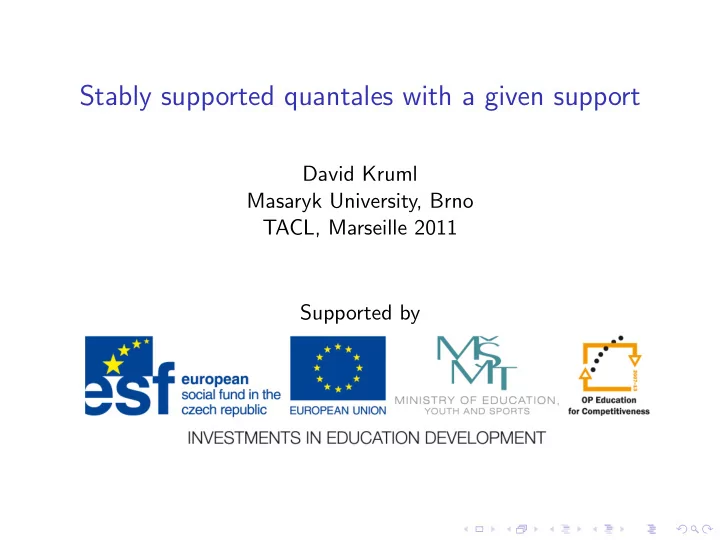

Stably supported quantales with a given support David Kruml Masaryk University, Brno TACL, Marseille 2011 Supported by
Quantales Sup-lattice — complete lattice, homomorphisms preserve arbitrary joins. Quantale — sup-lattice with associative multiplication which distrubutes over joins. Involutive quantale — quantale + involution, provided that a ∗∗ = a , ( ab ) ∗ = b ∗ a ∗ , � ∗ �� � a ∗ a i = i . Quantales are residuated (adjoints of the right/left action exist). 0 — bottom element, 1 — top element, e — unit (need not exists), r · 1 ≤ r — right-sided element, 1 · l ≤ l — left-sided element, both rules — two-sided element.
Examples of involutive quantales (1) Every frame is an involutive quantale with multiplication ∧ and trivial involution. (2) Binary relations Rel X on X set with � , ◦ , ∗ . ρ A = X × A , λ A = A × X (3) (J. Wick Pelletier, J. Rosick´ y 97) Quantale of endomorphisms Q ( S ) on a sup-lattice S . � � b � a , a b � = 0 , 1 ρ a ( b ) = λ a ( b ) = 0 b = 0 , 0 b ≤ 0 . If S is self-dual with a duality ′ , then Q ( S ) is involutive: � ′ �� α ∗ ( x ) = { y | α ( y ) ≤ x ′ }
Stably supported quantales (Resende 2003) Support — sup-lattice endomorphism ς : Q → Q , s.t. ς a ≤ e , ς a ≤ a ∗ a , ς a ≤ ς aa for any a ∈ Q . The support is called stable if ς a = e ∧ a for every a . Examples: (1) Rel X . (2) Quantales on ´ etale groupoids. Remark: ↓ e is a frame. SSQ is an involutive quantale “with enough projections”.
Problems (1) For a given self-dual sup-lattice S , is there a Girard quantale where S is the lattice of right- (left-) sided elements? [Yes, J. Egger & D. Kruml 2009.] (2) (A. Palmigiano) F , what are the SSQ where F appears as ↓ e ?
� � � � Triads categorically L • • Q T R T ⊗ T → T Q ⊗ Q → Q R ⊗ T → R Q ⊗ R → R T ⊗ L → L L ⊗ Q → L L ⊗ R → T R ⊗ L → Q 16 pentagonal coherence axioms + some of the 6 triangular axioms for unital objects.
� �� � � � � � Solutions � Q 0 R ⊗ T ⊗ L �� R ⊗ L ( T ⊗ L ) ⊸ L Q 1 L ⊸ L ( L ⊗ R ) ⊸ T R ⊸ R ( R ⊗ T ) ⊸ R Q 0 = R ⊗ T L , Q 1 = { ( φ, ψ ) | φ ( l ) r = l ψ ( r ) for any r ∈ R , l ∈ L , and φ, ψ are T -module endomorphisms of L , R , resp. } .
Involutive triads Triad ( L , T , R ) is involutive if T is commutative, and there is a T -module isomorphism L ∼ = R making the inner product L × R → T symmetric. If ( L , T , R ) is involutive, then Q 0 , Q 1 are involutive quantales: ( r ⊗ l ) ∗ = l ⊗ r , ( α, β ) ∗ = ( β ∗ , α ∗ ). Practical assumptions: L = R and T ⊆ L is an open frame homomorphism, i.e. it has both adjoints and satisfies Frobenius reciprocity condition | a ∧ t | = | a | ∧ t for a ∈ F , t ∈ T and left adjoint | − | : L → T . It induces an involutive triad ( L , T , L ) with inner product ( l , r ) �→ | l ∧ r | .
Main result Let T ⊆ L be an open subframe. Then solution Q 1 of involutive triad ( L , T , L ) is a SSQ, s.t. L , T appears as lattices of left/two-sided elements respectively (and thus L as the support as well). Examples: (1) If L = T , | − | = id , then Q 1 ∼ = L . (2) T = 2 , | 0 | = 0 and | x | = 1 otherwise. Remark: The construction works also for OML L and its centre T with the same assumption (the solution is no more a SSQ).
Thank you!
Recommend
More recommend